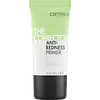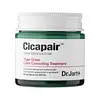Catrice The Corrector Anti-Redness Primer Versus Dr. Jart+ Cicapair Tiger Grass Color Correcting Treatment SPF 30
What's inside
What's inside
 Key Ingredients
Key Ingredients

 Benefits
Benefits

 Concerns
Concerns

 Ingredients Side-by-side
Ingredients Side-by-side

Water
Skin ConditioningDimethicone
EmollientGlycerin
HumectantTalc
AbrasiveCetyl PEG/PPG-10/1 Dimethicone
EmulsifyingIsododecane
EmollientCentella Asiatica Leaf Extract
Skin ConditioningTocopherol
AntioxidantSodium Chloride
MaskingAllantoin
Skin ConditioningMagnesium Sulfate
Tocopheryl Acetate
AntioxidantDisteardimonium Hectorite
StabilisingHydrogen Dimethicone
Ascorbyl Palmitate
AntioxidantPropylene Carbonate
SolventEthylhexylglycerin
Skin ConditioningMethicone
EmollientAluminum Hydroxide
EmollientPhenoxyethanol
PreservativeSodium Dehydroacetate
PreservativeBenzoic Acid
MaskingPotassium Sorbate
PreservativeDehydroacetic Acid
PreservativeSodium Benzoate
MaskingCI 77163
Cosmetic ColorantCI 77288
Cosmetic ColorantCI 77492
Cosmetic ColorantCI 77499
Cosmetic ColorantCI 77891
Cosmetic ColorantWater, Dimethicone, Glycerin, Talc, Cetyl PEG/PPG-10/1 Dimethicone, Isododecane, Centella Asiatica Leaf Extract, Tocopherol, Sodium Chloride, Allantoin, Magnesium Sulfate, Tocopheryl Acetate, Disteardimonium Hectorite, Hydrogen Dimethicone, Ascorbyl Palmitate, Propylene Carbonate, Ethylhexylglycerin, Methicone, Aluminum Hydroxide, Phenoxyethanol, Sodium Dehydroacetate, Benzoic Acid, Potassium Sorbate, Dehydroacetic Acid, Sodium Benzoate, CI 77163, CI 77288, CI 77492, CI 77499, CI 77891
Water
Skin ConditioningCentella Asiatica Leaf Water
Skin ConditioningIsononyl Isononanoate
EmollientCyclopentasiloxane
EmollientButylene Glycol
HumectantDimethicone
EmollientPhenyl Trimethicone
Skin ConditioningMethyl Methacrylate Crosspolymer
Beeswax
Emulsion StabilisingGlycerin
HumectantDiethylhexyl Carbonate
EmollientPolyglyceryl-3 Polyricinoleate
EmulsifyingNiacinamide
SmoothingPolymethylsilsesquioxane
Cyclohexasiloxane
EmollientPanthenol
Skin ConditioningDiglycerin
HumectantIron Oxides
Polyglyceryl-4 Diisostearate/Polyhydroxystearate/Sebacate
EmulsifyingIsododecane
EmollientEthylene/Methacrylate Copolymer
Cetearyl Alcohol
EmollientPolyglyceryl-2 Triisostearate
EmulsifyingAluminum Hydroxide
EmollientStearic Acid
CleansingDisteardimonium Hectorite
StabilisingAcrylates/Ammonium Methacrylate Copolymer
Sclerotium Gum
Emulsion StabilisingSodium Benzoate
MaskingAcrylates/Dimethicone Copolymer
Skin ConditioningHydrogen Dimethicone
Chromium Oxide Greens
Triethyl Citrate
MaskingPotassium Sorbate
PreservativeFragaria Vesca Leaf Extract
AstringentDisodium EDTA
BHT
AntioxidantAlcohol
AntimicrobialAsiaticoside
AntioxidantAdenosine
Skin ConditioningTriethoxycaprylylsilane
Lavandula Angustifolia Oil
MaskingBoron Nitride
AbsorbentAsiatic Acid
Skin ConditioningMadecassic Acid
Skin ConditioningCitrus Grandis Peel Oil
MaskingRosmarinus Officinalis Leaf Oil
Masking1,2-Hexanediol
Skin ConditioningAnthemis Nobilis Flower Oil
MaskingHouttuynia Cordata Extract
Skin ConditioningPropanediol
SolventCentella Asiatica Extract
CleansingGentiana Lutea Root Extract
Skin ConditioningArtemisia Absinthium Extract
Skin ConditioningAchillea Millefolium Extract
CleansingArnica Montana Flower Extract
MaskingPolysorbate 20
EmulsifyingAniba Rosodora Wood Oil
AstringentSodium Glycerophosphate
Selaginella Lepidophylla Extract
EmollientPotassium Magnesium Aspartate
BufferingCitric Acid
BufferingCalcium Gluconate
HumectantMadecassoside
AntioxidantMagnesium Gluconate
Skin ConditioningCentella Asiatica Meristem Cell Culture
AntioxidantXanthan Gum
EmulsifyingTitanium Dioxide
Cosmetic ColorantZinc Oxide
Cosmetic ColorantWater, Centella Asiatica Leaf Water, Isononyl Isononanoate, Cyclopentasiloxane, Butylene Glycol, Dimethicone, Phenyl Trimethicone, Methyl Methacrylate Crosspolymer, Beeswax, Glycerin, Diethylhexyl Carbonate, Polyglyceryl-3 Polyricinoleate, Niacinamide, Polymethylsilsesquioxane, Cyclohexasiloxane, Panthenol, Diglycerin, Iron Oxides, Polyglyceryl-4 Diisostearate/Polyhydroxystearate/Sebacate, Isododecane, Ethylene/Methacrylate Copolymer, Cetearyl Alcohol, Polyglyceryl-2 Triisostearate, Aluminum Hydroxide, Stearic Acid, Disteardimonium Hectorite, Acrylates/Ammonium Methacrylate Copolymer, Sclerotium Gum, Sodium Benzoate, Acrylates/Dimethicone Copolymer, Hydrogen Dimethicone, Chromium Oxide Greens, Triethyl Citrate, Potassium Sorbate, Fragaria Vesca Leaf Extract, Disodium EDTA, BHT, Alcohol, Asiaticoside, Adenosine, Triethoxycaprylylsilane, Lavandula Angustifolia Oil, Boron Nitride, Asiatic Acid, Madecassic Acid, Citrus Grandis Peel Oil, Rosmarinus Officinalis Leaf Oil, 1,2-Hexanediol, Anthemis Nobilis Flower Oil, Houttuynia Cordata Extract, Propanediol, Centella Asiatica Extract, Gentiana Lutea Root Extract, Artemisia Absinthium Extract, Achillea Millefolium Extract, Arnica Montana Flower Extract, Polysorbate 20, Aniba Rosodora Wood Oil, Sodium Glycerophosphate, Selaginella Lepidophylla Extract, Potassium Magnesium Aspartate, Citric Acid, Calcium Gluconate, Madecassoside, Magnesium Gluconate, Centella Asiatica Meristem Cell Culture, Xanthan Gum, Titanium Dioxide, Zinc Oxide
 Reviews
Reviews

Ingredients Explained
These ingredients are found in both products.
Ingredients higher up in an ingredient list are typically present in a larger amount.
Aluminum Hydroxide is a form of aluminum. It can be naturally found in nature as the mineral gibbsite. In cosmetics, Aluminum Hydroxide is used as a colorant, pH adjuster, and absorbent.
As a colorant, Aluminum Hydroxide may add opacity, or reduce the transparency. Aluminum hydroxide is contains both basic and acidic properties.
According to manufacturers, this ingredient is an emollient and humectant. This means it helps hydrate the skin.
In medicine, this ingredient is used to help relieve heartburn and help heal ulcers.
There is currently no credible scientific evidence linking aluminum hydroxide in cosmetics to increased cancer risk.
Major health organizations allow the use of aluminum hydroxide in personal care products and have not flagged it as a carcinogenic risk at typical usage levels.
Learn more about Aluminum HydroxideDimethicone is a type of synthetic silicone created from natural materials such as quartz.
What it does:
Dimethicone comes in different viscosities:
Depending on the viscosity, dimethicone has different properties.
Ingredients lists don't always show which type is used, so we recommend reaching out to the brand if you have questions about the viscosity.
This ingredient is unlikely to cause irritation because it does not get absorbed into skin. However, people with silicone allergies should be careful about using this ingredient.
Note: Dimethicone may contribute to pilling. This is because it is not oil or water soluble, so pilling may occur when layered with products. When mixed with heavy oils in a formula, the outcome is also quite greasy.
Learn more about DimethiconeDisteardimonium Hectorite comes from the clay mineral named hectorite. It is used to add thickness to a product.
It can also help stabilize a product by helping to disperse other ingredients.
Hectorite is a rare, white clay mineral.
Learn more about Disteardimonium HectoriteGlycerin is already naturally found in your skin. It helps moisturize and protect your skin.
A study from 2016 found glycerin to be more effective as a humectant than AHAs and hyaluronic acid.
As a humectant, it helps the skin stay hydrated by pulling moisture to your skin. The low molecular weight of glycerin allows it to pull moisture into the deeper layers of your skin.
Hydrated skin improves your skin barrier; Your skin barrier helps protect against irritants and bacteria.
Glycerin has also been found to have antimicrobial and antiviral properties. Due to these properties, glycerin is often used in wound and burn treatments.
In cosmetics, glycerin is usually derived from plants such as soybean or palm. However, it can also be sourced from animals, such as tallow or animal fat.
This ingredient is organic, colorless, odorless, and non-toxic.
Glycerin is the name for this ingredient in American English. British English uses Glycerol/Glycerine.
Learn more about GlycerinHydrogen Dimethicone is a type of silicone.
Isododecane is a fragrance, emollient, and solvent.
As an emollient, it helps your skin stay soft and hydrated. Emollients help trap moisture into your skin.
Isododecane's role as a solvent makes it a great texture enhancer. It spreads smoothly on skin and does not leave a sticky feeling behind. Isododecane also helps prevent color transfer in makeup products.
Isododecane is not absorbed into skin.
Learn more about IsododecanePotassium Sorbate is a preservative used to prevent yeast and mold in products. It is commonly found in both cosmetic and food products.
This ingredient comes from potassium salt derived from sorbic acid. Sorbic acid is a natural antibiotic and effective against fungus.
Both potassium sorbate and sorbic acid can be found in baked goods, cheeses, dried meats, dried fruit, ice cream, pickles, wine, yogurt, and more.
You'll often find this ingredient used with other preservatives.
Learn more about Potassium SorbateSodium Benzoate is a preservative. It's used in both cosmetic and food products to inhibit the growth of mold and bacteria. It is typically produced synthetically.
Both the US FDA and EU Health Committee have approved the use of sodium benzoate. In the US, levels of 0.1% (of the total product) are allowed.
Sodium benzoate works as a preservative by inhibiting the growth of bacteria inside of cells. It prevents the cell from fermenting a type of sugar using an enzyme called phosphofructokinase.
It is the salt of benzoic acid. Foods containing sodium benzoate include soda, salad dressings, condiments, fruit juices, wines, and snack foods.
Studies for using ascorbic acid and sodium benzoate in cosmetics are lacking, especially in skincare routines with multiple steps.
We always recommend speaking with a professional, such as a dermatologist, if you have any concerns.
Learn more about Sodium BenzoateWater. It's the most common cosmetic ingredient of all. You'll usually see it at the top of ingredient lists, meaning that it makes up the largest part of the product.
So why is it so popular? Water most often acts as a solvent - this means that it helps dissolve other ingredients into the formulation.
You'll also recognize water as that liquid we all need to stay alive. If you see this, drink a glass of water. Stay hydrated!
Learn more about Water